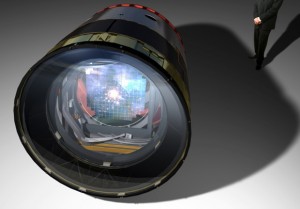World's largest digital camera one step closer to reality

The Large Synoptic Survey Telescope Project (LSST), a 3-billion pixel camera/telescope to perch atop the Cerro Pachón mountain peak in Chile, has received "Critical Decision 1" (CD-1) approval by the U.S. Department of Energy (DOE) to move into the next stage of the project.

The LSST camera will be the largest digital camera ever constructed, measuring roughly 5' x 10' (credit: LSST Corp.)
Now the project begins a detailed engineering design, schedule, and budget phase, with the DOE funding the design and construction. The full cost and logistics of the small car-sized telescope will be shared by the DOE and the National Science Foundation, as well as a large partnership of public and private organizations in the United States and abroad.
The LSST will capture about 6 million gigabytes per year, the equivalent of shooting roughly 800,000 images with a regular 8-megapixel digital camera every night. The images are expected to help unlock the secrets of dark energy and dark matter and aid studies of near-Earth asteroids, Kuiper belt objects, the structure of our galaxy, and many other areas of astronomy and fundamental physics.
"With 189 sensors and over three tons of components that have to be packed into an extremely tight space, you can imagine this is a very complex instrument," said Nadine Kurita, the project manager for the LSST camera at SLAC National Accelerator Laboratory. "But given the enormous challenges required to provide such a comprehensive view of the universe, it's been an incredible opportunity to design something so unique."
Data from the LSST will be made publicly available, so that anyone with a computer will able to fly through the universe, zooming past objects a 100 million times fainter than can be observed with the unaided eye. The LSST project will also provide analysis tools to enable both students and the public to participate in the process of scientific discovery.
"Not only should LSST revolutionize our understanding of the universe, its contents and the laws that govern its behavior, but it will also transform the way all of us, from kindergarteners to professional astrophysicists, use telescopes," said Tony Tyson, LSST director and a professor of physics at the University of California, Davis.
If the project continues as planned, construction on the telescope will begin in 2014. Preliminary work has already started on LSST's 8.4-meter primary mirror and its final site in northern Chile.